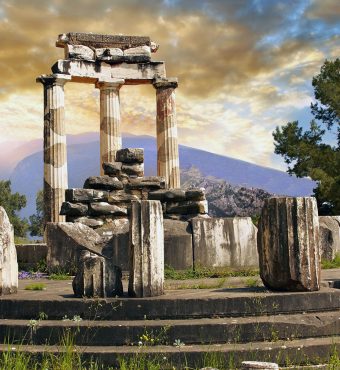Delphi & Arachova Tour

Visit the centre of the world, Delphi the ancient Google, the place where kings were seeking advice, how to rule and which places to colonise! Have fun in Arachova, the picturesque village on Mount Parnassos, known as Mykonos of the mountains for its lively nightlife and lifestyle!
The tour starts from the Archaelogical Site of Delphi. At the foot of Mount Parnassos, within the angle formed by the twin rocks of the Phaedriades, lies the Pan-Hellenic sanctuary of Delphi, which had the most famous oracle of ancient Greece. Delphi was regarded as the centre of the world. The sanctuary was originally the centre of the Amphictyonic League, an association of twelve tribes of Thessaly and the Sterea (south-central Greece), with religious and later political significance. The Amphictyonic League controlled the operation and finances of the sanctuary, as it designated its priests and other officials chosen from among the inhabitants of Delphi. In the sixth century BC, under the League’s protection and administration, the sanctuary was made autonomous (First Sacred War), it increased its territory and political and religious influence throughout Greece, and reorganised the Pythian Games, the second most important games in Greece after the Olympics, which were held every four years.
Between the sixth and fourth centuries BC, the Delphic oracle, which was regarded as the most trustworthy, was at its peak. It was delivered by the Pythia, the priestess, and interpreted by the priests of Apollo. Cities, rulers and ordinary individuals alike consulted the oracle, expressing their gratitude with great gifts and spreading its fame around the world.
The oracle was thought to have existed since the dawn of time. Indeed, it was believed to have successfully predicted events related to the cataclysm of Deukalion, the Argonaut’s expedition and the Trojan War; more certain are the consultations over the founding of the Greek colonies, e.g. Marseille.
The archaeological site of Delphi includes two sanctuaries, dedicated to Apollo and Athena, and other buildings, mostly intended for sports. Visitors arriving from Athens first encountered the sanctuary of Athena Pronaia – that is, Athena who is before the temple of Apollo. Outside its walls spread the settlement of Delphi. Within the walls were the famous Tholos, the symbol of Delphi today, and the remains of three temples dedicated to the goddess.
The Stadium of Delphi is one of the best-preserved monuments of its kind. It was reached in antiquity, like today, by a path winding up from the theatre’s left parodos. The stadium is closely connected to the history of the Pythian games, since this is where the athletic events took place. The stadium was built into the natural slope, its north side cut into the rock, its south side artificially supported by a walled terrace. The monumental entrance to the east consisted of a triple arch supported by four pillars, the two middle ones having niches for statues. This is where the judges and athletes of the Pythian Games entered the stadium under the acclamations of the audience. Behind the entrance is a rock-cut podium with five steps from an earlier building phase, and the remains of a fountain.
The Temple of Apollo, the most important building in the sanctuary of Apollo at Delphi, dominates the temenos from its central position. This is where the statues and other offerings to the god were kept, and where the cult rituals, including that of divination, took place. Also, here was the chresmographeion, or archive, destroyed in 373 BC, which contained the lists of victors of the Pythian games.
According to the legend, the first temple of Apollo at Delphi was made of laurel branches, the second of beeswax and feathers, and the third of bronze, while the fourth was built by the legendary architects Trofonios and Agamedes aided by Apollo himself.
The Theatre is situated above the Temple of Apollo and there took place all the theatrical and musical contests of the Pythian Games.
The Stoa of the Athenians is an ancient portico in the Sanctuary of Apollo in Delphi, Greece, located south of the Apollo Temple. The southern side of the polygonal wall of the platform forms the north wall of the Stoa. It was constructed c. 478 BC-470 BC during the early Classical period. The one-aisled Stoa with Ionic colonnade opens toward the southeast. It was dedicated by the Athenians to Apollo after the Persian Wars.
The Sibyl Rock: the rock from which the Sibyl gave oracles. The rock is between the treasury of Sicyon and the Stoa of the Athenians upon the sacred way which leads up to the Temple of Apollo in the archaeological area of Delphi. As Pausanias says at Phocis “there is a rock which extrudes from the ground. The Delphians say that after she stood above this rock, a woman named Herophile chanted her oracles, a woman who was known as a “Sibyl”.
The Athenian Treasury at Delphi was constructed by the Athenians to house dedications and votive offerings made by their city and citizens to the sanctuary of Apollo. The entire treasury including its sculptural decoration is built of Parian marble. It is located directly below the Temple of Apollo along the Sacred Way for all visitors to view the Athenian treasury on the way up to the sanctuary. Pausanias mentions the building in his account of the sanctuary, claiming that it was dedicated from the spoils of the Battle of Marathon, fought in 490 BCE against the Persians. The Battle of Marathon can be seen in some of the images of the metopes which compare their victory to mythology.
Visiting Delphi is undoubtfully a lifetime experience, but a perfect day tour should also include pleasure. Hence, we will visit also Arachova, a mountainous picturesque village at the foot of Mt. Parnassós in Viotia, Southern Greece. It is the most cosmopolitan winter destination in Greece and a great favourite for passionate ski lovers and celebrities, or just first-time visitors who wish to relax in a dreamy mountainous setting with modern tourism facilities. Its modern ski resort, its close proximity to Athens, and its breathtaking mountainous landscape are the strongest reason why. Apart from the mountain activities, Aráchova is also famous for its nightlife and as the favorite mountain resort of Athenians!
- 4 Persons Max / Car
- 8 Hours
- 270 € Price / Car
- Free Wi-fi
- Free cold water
- AC
- Licensed Driver
- Knowledgeable Driver
Explore more Daily Tours
Day Tours • explore_tours
Athens at a glance
Day Tours • explore_tours
Cape Sounion Tour
Day Tours • explore_tours
Corinth Tour
Day Tours • explore_tours









